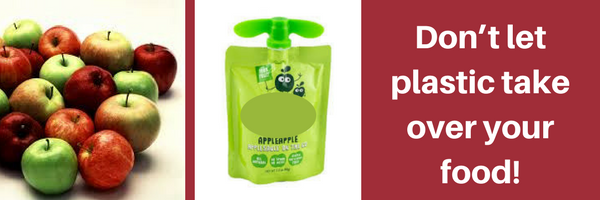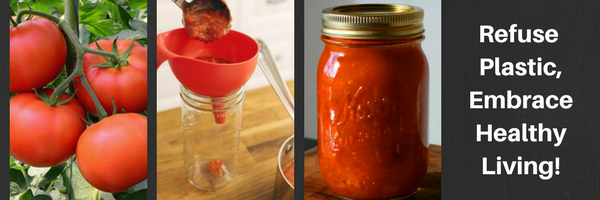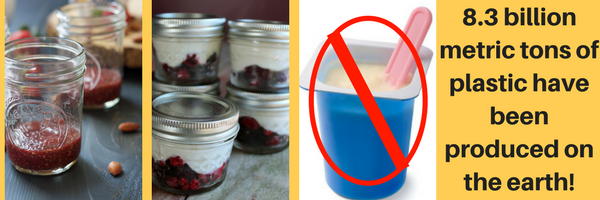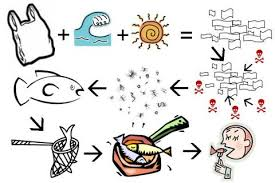This week’s blog will describe how I began eliminating single-serve food items, such as yogurt cups, individually wrapped cheese slices, frozen dinners, cup-a-soup, etc. A tremendous amount of plastic waste is created for food packaging. Everything comes sealed and tightly packaged in plastic. Even at health food stores it is challenging to avoid plastic.

Let’s first talk about the items that often come packaged in both glass or plastic. This is an easy switch to make with an immediate impact. When you are faced with the choice between plastic or glass, always choose glass. Glass can be recycled, plastic on the other hand cannot be recycled. Plastic is actually downcycled. For example, a water bottle will never be a water bottle again, it will be downcycled into resin fibers used for pillows or resin pellets used to make cheap deck furniture. The refabrication of plastic into resin fibers and pellets is labor and energy intensive (typically from fossil fuels). The best way to eliminate the impact plastics have on the environment is not by recycling, but first by reducing the use of plastics overall. We really need to add REFUSE to the three R’s. We need to begin to refuse to purchase items based on the packaging.

List of items you can choose glass over plastic: milk jugs/bottles, spaghetti sauce, condiments, juice, apple sauce, salsa, spices, baby food, etc.
Learning to make purchasing decisions based on plastic waste may take some adjustment. It may require you to spend a bit more, switch brands, or even give up a few items. But for nearly all food items packaged in plastic, there is an alternative (store bought or homemade).

The problem with inexpensive single-serve food items is that they are unhealthy in many ways. The obvious is that they are unhealthy for the environment. When we purchase plastic wrapped food items we are not paying the true environmental cost for those items. There is a tremendous amount of oil, water, and energy that goes into manufacturing plastic. A second unhealthy component of single-serve items is the dietary consequences. Single-serve food items are often high in sugar, preservatives, sodium, and/or fat. Think about how an apple has no plastic waste and is nutritious compared to a single-serve applesauce cup with added sugar and preservatives, not to mention the plastic waste. Next time you are at the grocery store skip the pre-packaged items!

There are some food items in the grocery store without glass or cardboard container options such as yogurt and frozen dinners. This can be challenging to deal with. One suggestion is to purchase in bulk or prepare the food item from scratch at home. For example, yogurt can easily be purchased in a large size container and used as needed at home or divided into smaller reusable containers when needed for on-the-go. Yogurt can also be easily made at home. The same goes for frozen dinners, full-size dinners such as lasagna, enchiladas, curry, soup, etc. can easily be made at home and divided into single-serve portions, and frozen in glass containers. The key is to find a system that works for your lifestyle.

At our house, when making dinner, such as pasta, we often make a larger batch of sauce in order to have extra to be frozen and used at a later time. It has been over two years since we have purchased single-serve yogurt. I don’t always have the time to make yogurt from scratch, so instead I will purchase an extra large-sized yogurt at Costco, make my own fruit compote, divide the yogurt into reusable glass jars, which can be easily taken on-the-go. While our system is not perfect and can certainly be approved upon, we are reducing plastic waste tremendously by not purchasing single-use food items.

Earlier this year an industrial ecologist, Roland Geyer, decided to find out how much plastic has been manufactured since its invention. To date, a total of 8.3 billion metric tons of plastic has been produced. That is a staggering amount and hard to grasp how large it is. All of the plastic would cover the country of Argentina ankle deep (the 8th largest country in the world). The reason plastic never goes away is because it does not degrade, it photodegrades. This means sunlight photodegrades plastic; breaking it into smaller pieces, but those pieces remain in our oceans, soil, waterways, and even enter the food chain. Below is a visual map of how plastic moves through the environment and eventually humans.

Check back with us next week for our final plastic-free blog.